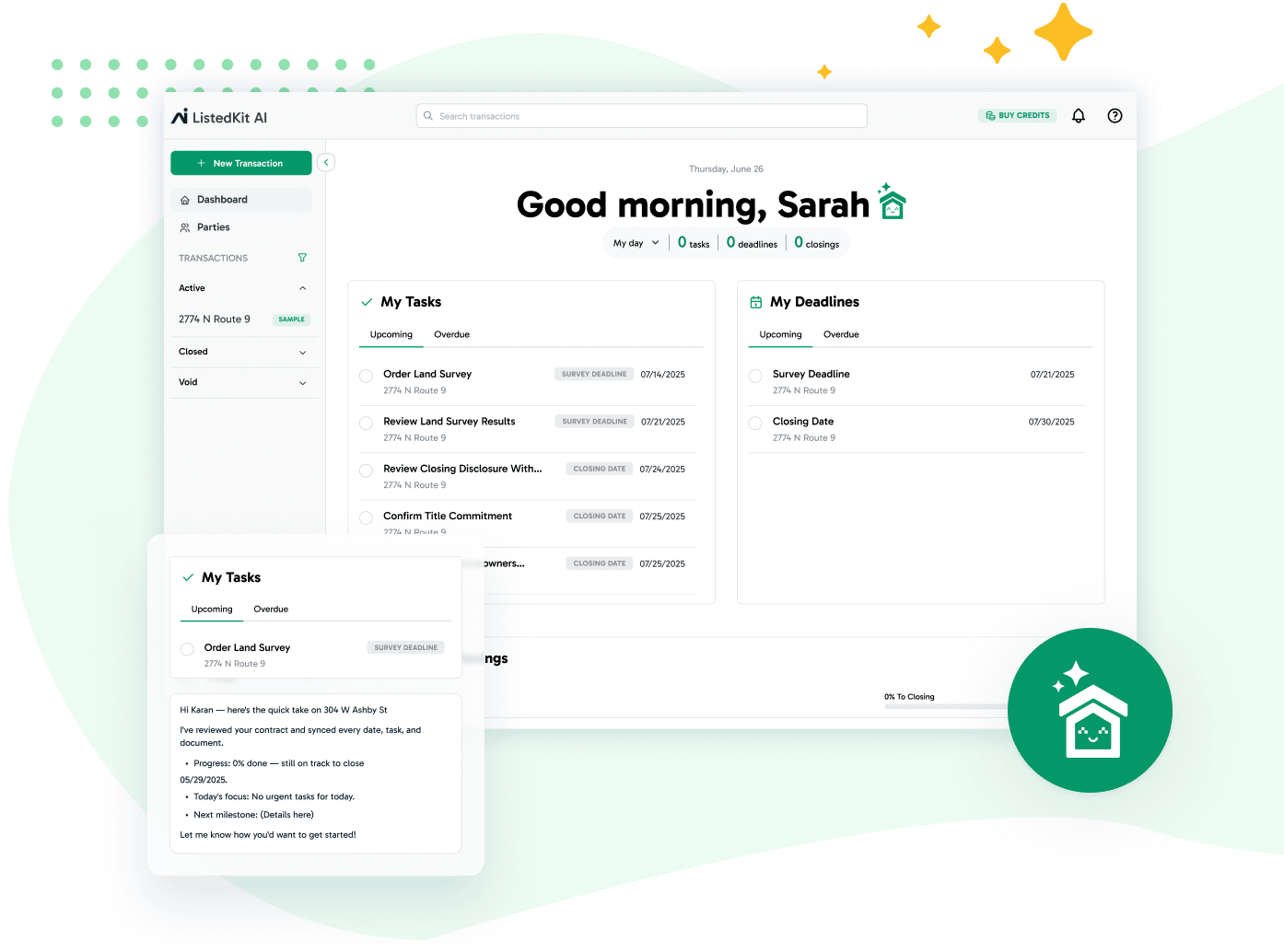How often do you wish for just a little extra time in your day? As a transaction coordinator (TC) or solo real estate agent, managing daily responsibilities can feel like a constant balancing act, leaving little room for focusing on growth. But what if you could save hours each month simply by making small adjustments to your business system?
Every additional second you waste making changes to an email, updating a file, or sending reminders yourself counts. These are small inefficiencies that will take hours off your schedule over time. By systemizing and smoothing out your processes, you can claw back that time and put it toward what really matters—building stronger relationships with clients or pursuing new opportunities.
In this guide, we’ll uncover actionable strategies for refining your workflow, saving time, and growing your business efficiently—starting with the power of saving seconds.
The Power of Saving Seconds
“Seconds add up to minutes, minutes add up to hours, and hours add up to days,” says Allyson Kurak, owner of Stitched Real Estate.
This insight highlights the cumulative impact of small inefficiencies, especially for transaction coordinators (TCs) and real estate professionals managing dozens of moving parts.
Tasks that seem trivial—tweaking a single email template, reorganizing files, or manually sending updates—can consume more time than you realize when repeated across multiple transactions.
Consider this: spending just 30 extra seconds on a task for 20 transactions equates to 10 minutes lost in a day.
Over weeks, this adds to hours of wasted time—valuable hours that could be spent building customer relationships, finding new leads, or refining your marketing strategy.
Implementing a smarter business system allows you to reclaim that time. By automating repetitive tasks, streamlining transaction workflows, and eliminating minor inefficiencies, you free up your schedule for activities that drive growth and give you a competitive advantage.
Start by Taking Inventory of Your Current System
To grow your TC business, you must first assess the state of your current business operations.
This means identifying inefficiencies in your business processes and understanding where you lose time. As a business owner, examining these elements closely helps you gain a 360-degree view of your workflow.
Steps to Take Inventory:
- Evaluate Repetitive Tasks. Identify tasks you perform daily or weekly, such as sending follow-up emails, organizing client files, or updating transaction logs. Repetition is a prime area for automation or optimization. For example, manually adjusting transaction timelines for each client eats into valuable minutes.
- Analyze Customer Relationships. Look at how you interact with clients and other stakeholders. Do your current tools or methods support seamless communication? A smooth customer experience is critical for maintaining satisfaction and growing your business.
- Survey Administrative Tasks. Consider tasks like file management, scheduling, and updates. These often go unnoticed but can significantly impact your overall efficiency. Streamlining them can improve customer satisfaction and allow you to focus on closing deals.
- Seek Feedback from Current Customers. Your clients are a great resource for understanding inefficiencies. Simple questions about your communication style, timeliness, or information delivery can provide valuable insights into areas for improvement.
Build Your Smarter Business System
Once you’ve identified problem areas, the next step is building a smarter business system to support your growth. This involves improving your workflows and implementing process automation solutions that save time and reduce effort. Here’s how.
1. Optimize Email Templates
Email communication is an essential part of the transaction coordination process. Yet, crafting individual emails for every update or reminder can be time-consuming. By focusing on optimizing this aspect of your workflow, you can save hours over time.
Why Email Templates Matter:
- Improved Customer Service: Clients value quick and clear communication. Well-structured email templates allow you to respond promptly while maintaining professionalism.
- Consistent Customer Experience: Templates ensure your tone and messaging remain consistent across all transactions, building trust and reliability.
Key Features of Effective Email Templates:
- Dynamic Fields for Personalization: To customize emails effortlessly, use placeholders for details like client names, property addresses, and dates.
- Pre-written Responses for Common Scenarios: Save templates for frequently asked questions or regular updates to eliminate repetitive typing.
- Clear Call-to-Action (CTA): Ensure every email has a purpose, whether prompting a signature, scheduling a meeting, or confirming a milestone.
Pro Tip:
A platform like ListedKit can automate email scheduling for key transaction steps, ensuring that follow-ups are not overlooked.
2. Leverage Automation Tools
Automation tools transform how business owners manage workflows, making repetitive tasks like reminders, updates, and notifications seamless. Beyond saving time, automation improves customer satisfaction by ensuring nothing falls through the cracks.
Areas for Automation:
- Follow-ups and Reminders: Automatically remind clients or stakeholders of deadlines without manual intervention. For example, set reminders for document reviews or inspection dates.
- File Sharing: Simplify how you send documents, ensuring they are automatically shared with the correct parties at the right time.
- Task Assignment and Tracking: Use digital solutions to assign and track tasks across your business development process.
Benefits of Automation for TCs:
- Increased Productivity: By freeing yourself from administrative tasks, you can focus on building customer relationships and finding new business opportunities.
- Competitive Advantage: Automation ensures faster turnaround times and error-free processes, setting you apart from competitors.
3. Streamline File Management
An unorganized file system isn’t just frustrating—it’s costly regarding time and client trust. A smarter approach to document organization ensures efficiency and professionalism.
Best Practices for File Organization:
- Centralize Your Files: Use cloud-based storage solutions to create a single document repository. This ensures accessibility anytime, anywhere.
- Adopt Consistent Naming Conventions: Include clear labels with details like client names, transaction types, and dates. For example, [Client Name]_[Transaction Type]_[Date].
- Archive Inactive Files: Archiving completed transactions keeps your workspace clutter-free and prevents you from accidentally editing or sending outdated files.
Why It Matters:
Organized file management saves you time and creates a seamless experience for potential customers who rely on you to provide accurate and timely documentation.
4. Improve Task Tracking
Clear task tracking is critical when managing multiple transactions. Without a robust system, you risk missed deadlines, frustrated clients, and wasted time. A streamlined process not only benefits you but also elevates your customer experience.
Implementing a Task Tracking System:
- Use Project Templates: Pre-built templates for each transaction type save time and standardize your workflow.
- Set Milestones: Break each transaction into clear phases, such as listing, escrow, and closing, with associated tasks.
- Assign Priorities: Mark urgent tasks to ensure critical deadlines are never overlooked.
Benefits for Business Operations:
Task tracking helps you maintain a wide range of simultaneous transactions without compromising on quality, allowing you to scale your services.
5. Invest in Professional Development During Slow Seasons
Real estate has its natural peaks and valleys. During slower seasons, like the holidays, take the opportunity to focus on improving your business systems. This downtime is ideal for tackling long-overdue updates and planning for the future.
Areas to Focus On:
- System Updates: Review and refine your email templates, file structures, and task workflows.
- Business Development Plan: Identify new business opportunities, refine your marketing strategy, and explore additional features to improve your services.
- Skill Building: Learn about process automation solutions or advanced analytics to future-proof your operations.
Long-term Impact:
Using slow periods effectively helps you stay ahead of the competition and improves your ability to meet customer preferences as your business grows.
Real-World Impact: How Small Changes Yield Big Results
Imagine you’re managing 15 transactions in a month, with each requiring routine administrative tasks like updating files, sending follow-up emails, and coordinating timelines.
If these tasks take 20 minutes per transaction, you spend five hours monthly on repetitive processes.
By refining your business system—automating email updates, using optimized templates, and streamlining file management—you could reduce this time to just 5 minutes per transaction. That’s a time savings of over 45 hours annually.
Now, think about what you could do with those reclaimed hours. Instead of being bogged down by tedious administrative tasks, you could focus on building strong customer relationships, enhancing your marketing campaigns, or even exploring new business opportunities.
These small, strategic changes improve efficiency, elevate the customer experience, and give you a competitive advantage. You position yourself for long-term growth and success by saving seconds in each task.
Create an Efficient System to Grow Your Business
Every second you save brings you closer to a more efficient, productive, and successful TC business. By identifying small inefficiencies and making incremental changes, you can reclaim valuable time to focus on what matters most—building relationships, growing your client base, and achieving long-term success.
Key takeaways to build a smarter system:
- Optimize your email templates: Save hours by reducing repetitive typing with dynamic fields and clear CTAs.
- Use automation tools: Handle follow-ups, file sharing, and task tracking without manual effort.
- Organize your files effectively: Create a clear, consistent system for easy document access.
- Adopt robust task tracking: Manage multiple transactions seamlessly and meet deadlines confidently.
- Use downtime for improvements: Focus on updates, skill-building, and planning during slower seasons.
With ListedKit, you can save time with smart email templates and schedule auto-sends to all parties. Get started for free today.




